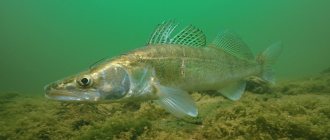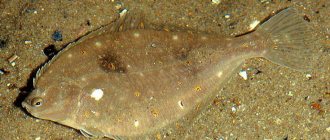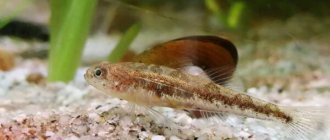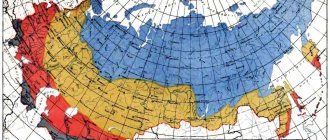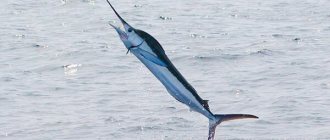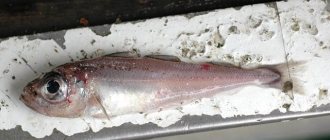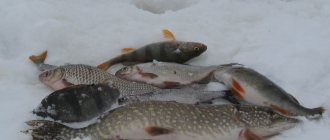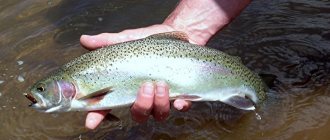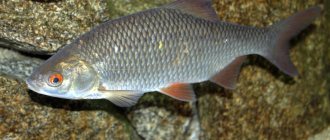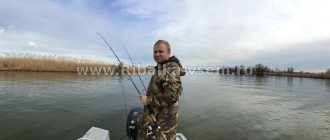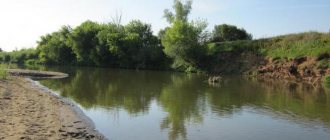What fish can you catch in the Black Sea?
The Black Sea is rich in both local inhabitants and migratory fish. Its waters are home to about 180 species of fish.
Often found:
- Horse mackerel;
- Red mullet;
- Sea bass;
- Herring;
- Ruff;
- Anchovy;
- Acne;
- Sprat;
- Mullet;
- Laskir (sea crucian);
- Garfish;
- Gorbyl.
Sea bass
Although outwardly sea perches are similar to river perches, in fact these two fish belong not only to different species, but even to different orders of fish. Fishermen call perch beaver or redhead. Indeed, it has a bright orange color. The fins of sea bass contain poisonous glands that look like needles. In case of an injection, a person experiences a slight but painful inflammation.
Sea bass is very voracious. It feeds on crustaceans, mollusks, plankton and many other marine life. Moreover, cases of cannibalism have been reported. Sometimes a perch can even eat the eggs that it itself laid! Another feature of perch is that initially they are all born female, but after about two years they begin to change their sex to male.
List, photos and features of catching certain types of fish in the Black Sea
You can fish in the Black Sea waters at any time of the year. The main thing is to know where the fish stay and the peculiarities of catching individual representatives.
Scorpena
The second name of the fish is sea ruff.
One of the most common fish of the Black Sea. The best catch of this fish is after a storm, when it is busy searching for food. The sea ruff is found in coastal areas up to 50 meters deep. Likes to hide in algae and accumulations of stones. It's good to start fishing at dusk, from rocks, piers or jetties.
Scorpion fish are greedy for bait. Reacts to vibrations in the water and rushes to the target with lightning speed. Therefore, to use its bait, experienced fishermen advise playing with a weight in the water, then raising and lowering it.
Let's celebrate! You should be extremely careful when removing fish from the hook, because... The fins have spines with poisonous glands. Injection with them can lead to severe pain and swelling of the affected area of the body.
Horse mackerel
Catching this fish is perfect for beginners, because...
No special skills are needed for this. During the hunting period, horse mackerel sometimes jumps out of the water in whole flocks. The best bite is observed before sunset and after sunrise. Summer and autumn are the best times of year for a good catch of this species. In spring the bite will not be as intense. Horse mackerel is not afraid of the noise of the motor and engine, so you can catch it directly from the boat.
It feeds on small fish. Suitable baits include shrimp, crustaceans, mussels, and worms. The bait comes in sharply and strongly, the main thing is not to miss the moment and hook it in time.
Goby
More than 10 species of goby can be found in the Black Sea.
This fish is the easiest to catch in the Black Sea. In winter, the goby goes deep into the water, and the best time for fishing is considered to be from mid-spring to mid-autumn. It is good to catch during daylight hours using bottom fishing rods from a pier, boat or shore. Conditions favorable for biting are small waves on the sea and air temperature not exceeding 25 degrees. In colder or warmer weather, the bite weakens.
The goby likes to live on rocky bottoms. You can hardly find it on the sandy one. The goby is omnivorous, so you don’t have to worry about choosing bait. The fish bite is characterized by a slight twitch. Goby can be caught using bottom gear with or without a float.
Mullet
You need to look for mullet in the area of rocks, piers, abandoned piers.
She swarms there in search of prey: mussels, rapans, worms. The main baits for catching mullet include:
- Bread crumb;
- All kinds of worms;
- Mussels.
On a note! The most successful bait for catching mullet are sea worms. They are easy to find under rocks or in sea soil.
Feeding fish will also be useful. As complementary foods, it is recommended to use a mixture of several ingredients (processed cheese, flour, bread, anchovy, mussel meat, etc.). Mullet goes hunting in the morning. This time of day is considered the best for fishing from the shore.
At night, fishing from a boat, away from the coastal zone, will be successful. Large mullet can be caught on a gloomy day when there is a slight wind blowing and drizzling rain. In such weather, schools of mullet usually enter small lagoons and bays in search of food (small fish, mussels).
Let's celebrate! You can catch this fish in the Black Sea all year round, but the best results will be from November to April. It will be convenient to catch mullet both with a spinning rod and with a float rod or donka.
Gorbyl
Gorbyl is also a resident of the Black Sea.
Its behavior is similar to that of the common perch. This fish rarely swims in schools, usually only in pairs. Having caught one representative of the species, you can immediately expect a bite from its partner.
Most often, croakers can be found in areas of rocks, steep banks, as well as in areas with soil made of sand, silt or shell rock. Croaker fishing on the Black Sea coast lasts from April to December. Best period for fishing: July – August.
This fish can be caught with a fishing rod from the shore, but the catch will be greater if it is done from a boat. There are 2 types of croaker in the Black Sea: black and light.
Light croaker are much less common. The croaker is a predatory fish, reaching 75 cm in size. It preys on small fish and larger ones (mackerel, sea crucian).
On a note! The croaker is attractive for spearfishing.
As dusk approaches, biting activity increases. The bait can be very diverse. Croakers are caught on a fishing rod with a hard or light rod, and on a donka.
Zubar
Catching bison or bison is popular among amateur fishermen.
This fish can be found in almost all regions of the Black Sea. The bison is not considered a fish - a hunter. Its diet mainly consists of plant foods, as well as worms and shrimp. Zubarik is a medium-sized fish weighing 700 - 800 grams. Adults that have lived for 5 or more years gain maximum weight, approximately equal to two kilograms. Zubar can most often be found in the coastal region at a depth of 5 to 10 meters.
For its habitat, the fish chooses places with sea currents. The bison has a fairly quick reaction and behaves extremely carefully. Therefore, an underwater hunter rarely manages to meet him.
Zubarik stays in small flocks. Spawning occurs in the autumn. During the daytime, the fish prefers to travel in algae and grass. At night the bite increases significantly.
Let's celebrate! Experienced fishermen know that it is better to catch bison from a pier or boat when the depth reaches 8 - 10 meters. The bison is a fairly strong fish with a strong jaw and always bare teeth. You should not forget about these physiological characteristics when going fishing.
Pelengas
Contrary to the beliefs of some fishermen, it is possible to catch pelengas not only from boats and boats, but also from the shore and just the pier.
Long-distance casting is typical for fishing from the shore, so you should choose long rods. This fish is very picky, so it is best to choose a sea worm for bait. All other gains will be ineffective. The pelengas feeds mainly on algae and organic remains.
When choosing attachments, you should take into account that the pelengas has no teeth. The fish is quite strong and offers considerable resistance when fished. In weight it reaches 2.5 - 3 kg, and in length - 40 cm.
The pelengas bite begins in mid-May and continues until mid-November. It has been noticed that fish activity in the morning is higher than in the afternoon and evening. A storm will be unfavorable for catching bearfish, but the post-storm period often coincides with the period of post-spawning feeding.
Let's celebrate! Southern and western winds also have a beneficial effect on the bite.
There is no need to loosen the line after the bearing is on the hook.
Goby
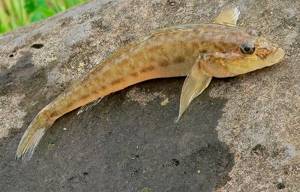
Photo: viridiflavus / Wikimedia Commons
Lives in coastal waters near the bottom. Most species of gobies have a body covered with scales. These fish got their name because of their heads. It is very wide, and the eyes are set very close to each other. Gobies have two fins on their backs, and a special suction cup on their belly. With its help, they can attach to rocks at the bottom. This allows you to stay in your usual habitat even during a strong storm.
There are 31 species of gobies in the Black Sea. They are divided into a group of brackish fish and a group of sea gobies. The former can withstand significant fluctuations in water salinity, and therefore they are also found in freshwater rivers. They lived in the Black Sea even when it was connected to the Caspian Sea. And sea gobies began to appear in the Black Sea relatively recently; they move here from the Mediterranean Sea (previously, these two bodies of water were separated). The weight of one bull can range from 100 to 200 grams.
Tackle for fishing in the Black Sea
Any gear is suitable for fishing in the Black Sea, but there are certain requirements.
The tackle should be:
- Durable;
- Well castable over long distances;
- Resistant to strong sea waves and gusts of wind.
In sea fishing, spinning rods, donks, tyrants, telescopic and float fishing rods are popular.
| Types of gear | Maximum fish weight | Fishing places | Fish caught with this tackle |
| Spinning | 5 kg | Pier, rocks, boat | Croaker, tuna, crucian carp, anchovy, sea bass, bonito, eel. |
| Bottom tackle | 4 – 5 kg | Quiet harbors, shallow waters | Eel, flounder, croaker, bison, red mullet. |
| Homemade fishing rods (tyrants) | 3 kg | Shore | Sea crucian, eel, goby, herring |
| Telescopic fishing rod | 3 – 4 kg | Pier, boat, rocks | Pelamide, tuna, beluga, goby |
| Float rod | 2 - 3 kg | Pier, areas with shallow muddy bottom | Horse mackerel, garfish, eel, bonito, anchovy. |
Sea Horse
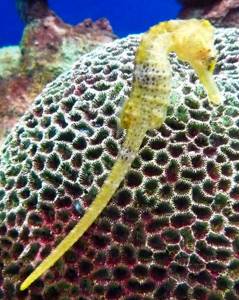
The shape of the seahorse resembles a “knight” chess piece, which is why the fish got its name. In the Black Sea there are several species of seahorses, whose sizes range from 2 to 30 cm. The shape of the skates does not allow them to move quickly in the water, but they do not need it. With the help of their tail, they attach to plants, after which they change color, merging with them. This allows you to protect yourself from predators.
At the same time, seahorses themselves are predators. They feed on shrimp and crustaceans. Skates simply use their pipette-like mouth to suck in water when prey swims near them.
Seahorses are distant relatives of pipefish and therefore reproduce in a similar way. The female lays eggs in the male's body. This fish is considered a special delicacy, although many species are listed in the Red Book. In some high-end restaurants, a seahorse dish costs $800.
Effective attachments
Mollusks, crustaceans, small fish, and various worms (sea, earth, dung) are ideal for sea fishing.
The table below shows popular baits for fishing in the Black Sea waters:
| Nozzles | Fish |
| Crab meat | Wrasse, goby, sea ruff |
| Shrimp | European bison, croaker, horse mackerel, weasel |
| Mussel | All marine species except mullet |
| Tilitrids (sea fleas) | Goby, mullet, wrasse |
| Sea worm (nereid, sandworm, etc.) | Zubar, mullet, scorpionfish and other sea fish |
| Animal spleen | Goby, flounder, mullet, sea crucian. |
| Pieces of small fish | Scorpionfish, goby, sea bass, horse mackerel, herring, etc. |
The Black Sea is attractive not only for its resorts and unforgettable views. Experienced fishermen love it for the opportunity to catch a good catch of tasty sea fish. Fishing places can be very diverse: rocks, shore, pier, abandoned creeks and the open sea. There are also no restrictions in the choice of gear and attachments.
Important! Before you start fishing, it is recommended to familiarize yourself with the basic nuances of catching a particular fish.
Anchovy
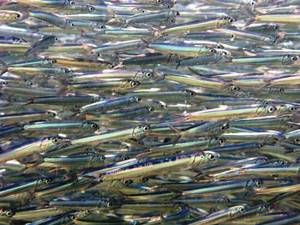
The second name of this commercial fish is European anchovy. The length of an adult does not exceed 20 cm. The anchovy's belly is white, and its back is green. Anchovy move in large schools at a depth of 40-70 m. Moreover, such schools are accompanied by dolphins, who happily snack on this fish.
The Azov and Black Sea anchovy are distinguished separately. The first is smaller, and it spends the summer in the Sea of Azov. Spawning and growth of fry take place here. Then the schools move to the Black Sea for the winter, and one of the largest wintering pits is located near Novorossiysk.
General information
The Black Sea is the final link in a long chain of Mediterranean seas. Because of this feature, it is inhabited by a minimal number of fish. All of them are of oceanic origin and live only in water that is similar to their natural environment. However, with distance from the Strait of Gibraltar, its composition, quality and natural wealth change. Because of this, only some species of fish have adapted to the conditions of the Black Sea, which are unpretentious in food and can withstand sudden changes in the environment.
There are approximately 500 species of fish in the Mediterranean basin, but only 180 of them can be found in the Black Sea. Some of them live there permanently, while some species come only for a certain period of the year. Because of this, the diversity of Black Sea fish is further reduced.
List of the most famous representatives of ichthyofauna:
- beluga;
- sturgeon;
- herring;
- stellate sturgeon;
- Black Sea anchovy;
- sprat;
- sprat;
- mackerel;
- tuna;
- horse mackerel.
Some fish species in the Black Sea are of great commercial importance. They are caught en masse, which leads to a decrease in populations and the gradual extermination of the species. These include the following types:
- goby;
- sea ruff;
- sea Horse;
- stickleback;
- greenfinch;
- angler;
- gurnard.
Until recently, 3 species of mullet lived in the Black Sea, but severe pollution and industrial fishing brought them to the brink of extinction. To correct the situation, a bearing was brought in. It adapted well to environmental conditions and began to actively reproduce. The consequence of this was its industrial catch, which is strictly controlled and helps the pelengas avoid the fate of other types of mullet.
